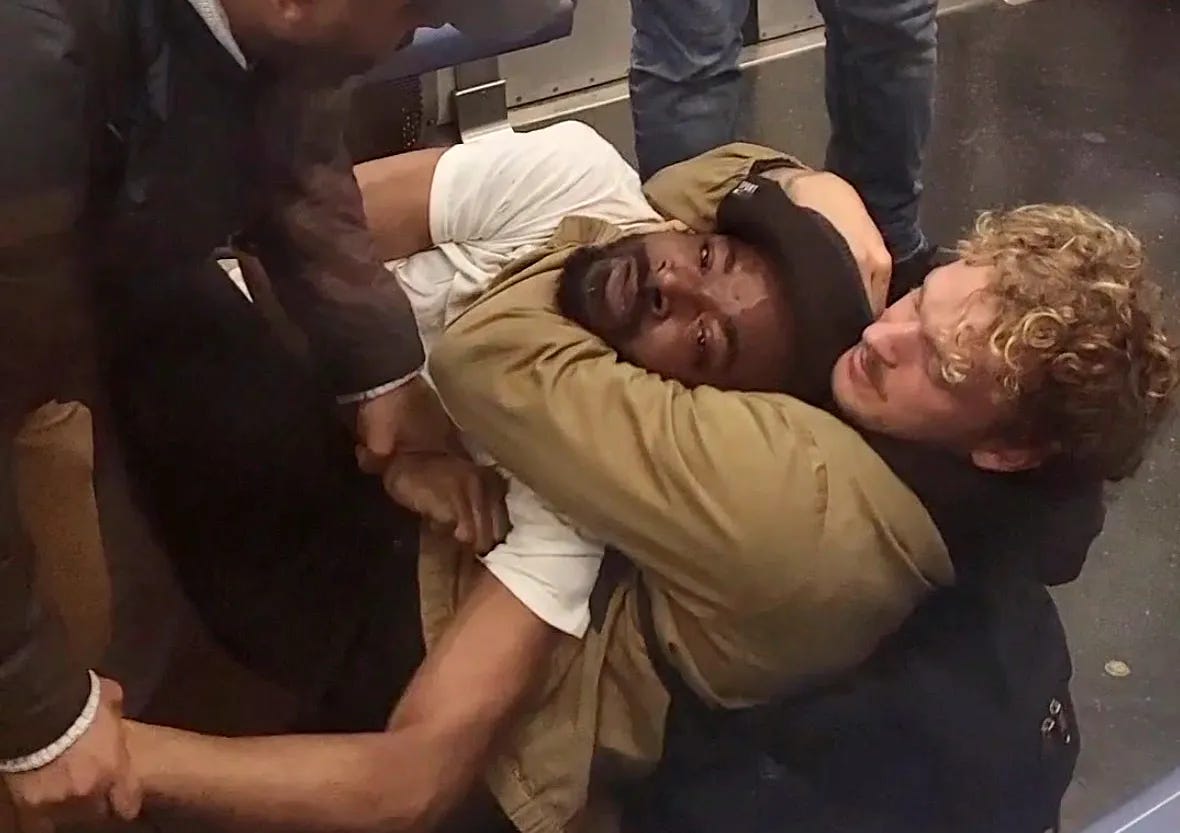O.J. Simpson and the Daniel Penny Case
In the trial of Daniel Penny, the ideological pursuit of racial justice overshadows the pursuit of justice itself.
Reality’s Last Stand is a reader-supported publication. Please consider becoming a paying subscriber or making a one-time or recurring donation to show your support.
About the Author
Eli Steele is a filmmaker whose latest films are Killing America and What Killed Michael Brown?. He can be found on X (@Hebro_Steele) and his substack is Man of Steele.
A version of this essay originally appeared on the author’s Substack The Man of Steele.
The trial of Daniel Penny in New York City has garnered national attention, raising questions about self-defense, race, and the influence of ideology in the criminal justice system. Penny, a 24-year-old Marine veteran at the time of the incident, is accused of causing the death of Jordan Neely, a 30-year-old subway performer, in a confrontation that escalated on a Manhattan train. The case is not only about the specific events that unfolded that day but also about broader societal issues, including the role of race in the judicial process and the balance between justice and restorative policies.
Penny’s account of the events sheds light on the intense atmosphere in the subway car. He recounted that Neely boarded the train while repeatedly saying, “I’m gonna kill everybody. I could go to prison forever, I don’t care,” and other violent declarations including that he would “kill a motherfucker.” Fearing for his safety and that of others, Penny, with the assistance of two fellow passengers, restrained Neely by pinning him to the floor and applying a chokehold.
Neely was later pronounced dead at a nearby hospital, and Penny turned himself in to authorities. He was released a few hours later without charges. Days later, Manhattan District Attorney Alvin Bragg confirmed that his office was investigating Penny who was soon charged with manslaughter, a crime that carries a penalty of five to fifteen years in prison.
It was at this point that race entered the public discourse. Of course, the optics were there all along: Penny is white and Neely was black. While these facts should not be relevant to the legal assessment of Penny’s actions, race was sinisterly thrust into the spotlight when Bragg entered the picture. Bragg, who campaigned on pursuing racial equity as a guiding principle, has established a controversial reputation for consistently favoring people of color—including criminals—above all other considerations. He prioritized identity politics over justice.
Bragg’s prosecutorial history includes controversial cases that reflect his commitment to racial equity at the expense of clear-cut justice. Perhaps the most famous example was his decision to charge Jose Alba, a clerk at the Blue Moon bodega in Harlem, with murdering ex-con Austin Smith with a knife during a fight, despite video evidence clearly showing that Alba was defending himself from Austin who initiated the attack. But for Bragg, Alba was a light skinned latino, which meant that Austin’s blackness mattered more. Achieving racial equity outweighed justice.
The lawyer assigned to Penny’s case, Manhattan prosecutor Dafna Yoran, has publicly embraced a policy of pursuing racial equity through restorative justice. In 2109, she sought and received a reduced sentence for Matthew Lee, a Black man who approached Dr. Young Kun Kim, a former Lehman College professor aged 87, while he was withdrawing cash from an ATM and fatally struck him. All for just $300.
In a subsequent interview, Yoran described Lee as a man driven to desperation, emphasizing his circumstances over the victim’s fate:
I had a murder case where the defendant did not intentionally kill the victim. I took the time to learn about the defendant.... I really felt incredibly sorry for him that he had gotten to that point in his life where he felt there was no choice but to commit this robbery.
Yet, in Penny’s case, no such empathy has been extended. Instead, Yoran has repeatedly characterized Penny during the trial as a “white man” and a “murderer,” statements that frame the trial within a narrative of systemic racial injustice. She also argued to the jury that Penny “didn’t recognize that Jordan Neely was a person. He saw him as a person that needed to be eliminated.”
The prosecuting team has made race a central issue in this case. The only reason to repeatedly refer to Penny as a white man is to tie him to the sins of America’s racist past. As my father would say, this is classic “white guilt” at play. But white guilt is not actual guilt, for one cannot be guilty for acts in the past that one did not commit. Rather white guilt is the fear of being stigmatized as a racist as well as the desire to dissociate oneself from America’s racist past. The prosecutor has made it her identity and esteem to pursue not justice, but racial justice by putting a white man—not a human—in jail.
Playing this kind of a race card is as old as America itself. My father’s book White Guilt offers many striking parallels to today’s events, particularly his reflections on the O.J. Simpson trial:
In the O. J. Simpson murder trial, defense attorney Johnnie Cochran used the fact that Detective Mark Fuhrman lied on the witness stand about having ever used the N word to assert that the entire mountain of evidence pointing to Simpson’s guilt was likely contaminated with racism. Here again was the disproportion that global racism always seeks. From a man who lied to conceal an embarrassment, Fuhrman was transformed into someone who could very likely be a craven racist, a person capable of malice aforethought who might prowl Simpson’s property planting evidence against him everywhere. So powerful was global racism in the case that even the possibility that this implausible caricature might be true was given more weight than solid DNA evidence linking Simpson to the murders. The mere suggestion of racism proved the rule of virulent racism. What this meant in this court was that the bar for “reasonable doubt” was completely defined by global racism. And the court itself-like most American institutions in this age of white guilt-was so bereft of moral authority in racial matters that it could not restore proportionality to the proceedings. It could not stop the Fuhrman caricature from carrying the day. Racism was allowed to become a kind of contaminating ether that wafted through and dispelled even the hardest evidence.
Johnnie Cochran succeeded in making the trial a contest between the empirical evidence and global racism, between fact and the reputation of racism for distorting and manipulating fact. What he gambled on was that the court—on television before the world—would have to show itself, above all else, deferential to racism’s distorting power. Though this black lawyer saw racism everywhere, he did not gamble his case on the court’s being racist; he gambled it on the court’s being obsessed with showing its utter freedom from racial bias, its determination to let even a hint of racism disqualify sound evidence. Johnnie Cochran instinctively understood that the court—an American institution in the age of white guilt—was infinitely more concerned with its own moral authority and legitimacy than with the truth. He knew the court would allow global racism to be the standard for “reasonable doubt” not because it was a reasonable standard but because it gave the court—in this trial of a famous black man-much-needed legitimacy where race was concerned. In sum, he knew that the court would essentially forgo the evidence against Simpson simply to prove that it was not biased against Simpson.
Of course, Cochran could not have invented global racism just for use in this trial. It had to have existed already in American culture, and it had to have a self-evident plausibility and power that he could pit against the plausibility of empirical fact. In the age of racism, racism itself had been such a power. White supremacy had been a higher and more sacred law than the law of the courtroom, so that whites who murdered blacks rarely even went to trial or, if they did, walked free no matter the evidence against them.
In 1955 the conviction of the white murderers of Emmet Till (the black teenager famously murdered for looking at a white woman in Mississippi) would have fractured the social order of the segregated South, so the facts in the case meant nothing and the murderers walked. White supremacy had to be served, just as white guilt was served in the Simpson case. Both Till's killers and Simpson enjoyed a “race card.” Both invoked their race to gain immunity from the law. (Interestingly, in today’s age of white guilt, there is even talk of reopening the Till case.)
Does the historical symmetry of all this amount to historical justice—Simpson’s black race card evening the score with the Til killers white race? I don’t think so. It only makes the point that we have not yet achieved an America in which race cannot suspend the law.
The ideological lens through which the DA’s office views Penny’s case is part of a broader trend in American institutions. Bragg’s and Yoran’s focus on racial equity aligns with a worldview that casts whiteness as inherently oppressive and people of color as perpetual victims. While historical injustices highlight the importance of combating racism, using race to distort justice in the opposite direction perpetuates the same cycle of inequality.
As my father argues, both white supremacy in the past and white guilt today undermine the impartiality of the legal system. The Penny trial exemplifies this shift, where the ideological pursuit of racial justice overshadows the pursuit of justice itself. Institutions captured by such ideologies prioritize symbolic victories over individual accountability, perpetuating racial division rather than healing it.
The trial of Daniel Penny represents more than a tragic altercation on a New York subway; it reflects the growing tension between justice and ideology in modern America. By centering race in the proceedings, the Manhattan DA’s office has turned a case about public safety into a battleground for broader cultural conflicts. Whether Penny is guilty of manslaughter should be decided on the evidence, not as a referendum on America’s racial history. Justice, to be truly just, must rise above ideology and remain anchored in the principles of fairness and truth.
UPDATE: On December 9, 2024, Daniel Penny was found not guilty of criminally negligent homicide.
Read more from Eli Steele on Man of Steele.
You made it to the end! You must have enjoyed the article. If so, please consider upgrading to a paid subscription or making a recurring or one-time donation below. Reality’s Last Stand is a reader-supported publication, and your help is greatly appreciated.












"I really felt incredibly sorry for him..." Could this be a civilizational epitaph, a total summation of modern liberalism or both?
The Social Justice faith, which is part Christian heresy and part Marxist permanent revolution, subordinates the rule of law, the will of the voters, and the health and safety of society to what it sees as larger moral and spiritual concerns: Justice and Equality, as defined in their terms as the Parable of the Good Samaritan combined with a transformation of Marx's "From each according to his ability, to each according to his needs" into "From each according to his privileged identity, to each according to his marginalized identity."
And in modern America the most popular arena for this spiritual warfare is our unfortunate racial history and the black/white divide that has defined us for so many centuries. America's racial wound is also our Achilles' Heel and there is an infinite line of lost souls, crusaders, charlatans, and various opportunists all waiting their turn to squeeze it for their benefit—whether they're seeking legal, financial, career, or spiritual and emotional rewards.
Daniel Penny is a hero. Full stop. Alvin Bragg is an ideological tyrant. Full stop.